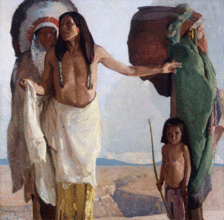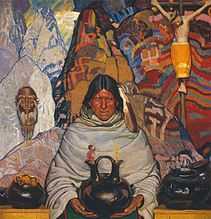Ernest L. Blumenschein
| Ernest L. Blumenschein | |
|---|---|
 Haystack, Taos Valley, before 1927. Oil on canvas. Museum of Art, University of Oklahoma | |
| Born |
May 26, 1874 Pittsburgh, Pennsylvania |
| Died |
June 6, 1960 Albuquerque, New Mexico |
| Nationality | American |
| Field | Painting |
| Training |
Art Students League of New York Académie Julian |
| Movement | Taos Society of Artists |
Ernest Leonard Blumenschein (26 May 1874 – 6 June 1960) was an American artist and founding member of the Taos Society of Artists. He is noted for paintings of Native Americans, New Mexico and the American Southwest.
Early life and education
Ernest Blumenschein was born on May 26, 1874 in Pittsburgh, Pennsylvania.[1] When four years later his mother died, his father accepted a position as director of the Dayton Philharmonic in Ohio, where Blumenschein grew up. When he finished high school, Blumenschein received a scholarship to study violin at the Cincinnati College of Music.[1][2]
While in Cincinnati, he also attended an illustration course from Fernand Lungren at the Cincinnati Art Academy, causing him to change his studies from music to art. He moved to New York City in 1892, studying at the Art Students League of New York. Attracted by the idea of studying art in Europe, he enrolled at the Académie Julian in Paris in 1894. There he met and became friends with Bert Phillips and the older and more experienced artist Joseph Henry Sharp, who told the two younger artists about his 1893 visit to Taos, New Mexico.[1]
Career

Blumenschein returned to New York in 1896, to work as an illustrator in a studio shared with Bert Phillips. In early 1898, he took an assignment that required him to travel to Arizona and New Mexico. That Spring, he convinced Phillips to join him on a second journey to the American West. Their first stop was Denver, Colorado, where they bought art and camping supplies, a wagon, horses and a revolver. Thus equipped, they set out with the intention of reaching Mexico.[1]
In northern New Mexico, the rough road caused a wagon wheel to break. Blumenschein brought the wheel to be repaired in nearby Taos, leaving Phillips alone with the wagon. When Blumenschein returned three days later with the repaired wheel, they continued to Taos, where they sold their horse and equipage, set up a studio and began to paint.[1]

Blumenschein stayed in Taos for three months, returning to New York to resume his career as an illustrator of popular magazines and books (including two short stories by Jack London),[3] while Phillips remained in Taos. Blumenschein returned twice to Paris to pursue further studies at Académie Julian: once in 1899 and again from 1902 to 1909. During the latter stay, he met and married artist Mary Sheppard Greene.[1][4]
The couple returned to New York in 1909, where they worked as an illustration team. Blumenschein also took a teaching position at his alma mater, the Art Students League of New York. In 1910, Blumenschein was elected into the National Academy of Design as an Associate member, and became a full member in 1927.[5]

From 1910, he spent his summers in Taos. In 1915, he became a co-founder of the Taos Society of Artists, together with his friends Bert Phillips, Joseph Henry Sharp, and three other artists. He finally settled permanently in Taos in 1919. From 1920 to 1921 he served as president of the Society. In 1923, he refused to accept the position of secretary of the Society, giving his commitment to an office of The New Mexico Painters, another group he had helped form, as his reason for the refusal. The other members of the Society refused to accept his excuse, and after a heated argument, Blumenschein resigned from the Society.[1]
The style of painting of the Taos painters was to decisively influence the perceptions that the wider world came to have of the American Southwest, specifically of the Pueblo and Navajo Indian peoples.
Collections
Paintings by Blumenschein are held in the Eiteljorg Art Museum in Indianapolis, Indiana, the Harwood Art Museum in Taos,[6] the Taos Art Museum and Fechin House,[7] the New Mexico Museum of Art[8] in Santa Fe, New Mexico and the El Paso Art Museum in El Paso, Texas.
Gallery
-

Untitled lithograph, 1898
-

The Peacemaker (The Orator), 1913
-

Eagle Fan, 1915
-
Portrait of Albedia, c. 1918
-

Superstition, 1921
See also
- Ernest L. Blumenschein House, his home in Taos, New Mexico
- Joseph Henry Sharp
- Oscar E. Berninghaus
- E. Irving Couse
- W. Herbert Dunton
- E. Martin Hennings
Notes
- ↑ 1.0 1.1 1.2 1.3 1.4 1.5 1.6 Peters, Gerald III (ed.) The Taos Society of Artist: Masters and Masterpieces. Gerald Peters Gallery, 1998. ISBN 0-935037-78-0
- ↑ Hassrick, 16
- ↑ Hassrick, 49
- ↑ Taos Historical Museums: E.L.Blumenschein Home Retrieved August 29, 2010
- ↑ http://www.nationalacademy.org/academy/national-academicians/
- ↑ Harwood website Retrieved August 29, 2010
- ↑ Taos Society of Artists Retrieved August 29, 2010
- ↑ "Searchable Art Museum". New Mexico Museum of Art. Retrieved 9 July 2013.
Further reading
- Hassrick, Peter H.; Cunningham, Elizabeth J. In Contemporary Rhythm: The Art of Ernest L. Blumenschein. University of Oklahoma Press, 2008. ISBN 978-0-8061-3948-7.
- Larson, Robert W.; Larson, Carole B. Ernest L. Blumenschein: The Life of an American Artist. University of Oklahoma Press, 2013. ISBN 978-0806143347.
External links
| Wikimedia Commons has media related to Ernest L. Blumenschein. |
- Denver Art Museum: In Contemporary Rhythm: The Art of Ernest L. Blumenschein
- Museum Association of Taos: E.L. Blumenschein Home and Museum
- PBS NewsHour: Witness to the American West (narrated slide show)
- Phoenix Art Museum: In Contemporary Rhythm: The Art of Ernest L. Blumenschein
- Archives of American Art, Smithsonian Institution: Ernest Blumenschein papers, 1873-1964
- Taos Historic Museums: E.L. Blumenschein Home
- Paintings
- Afternoon of a Sheepherder (1939)
- Haystack, Taos Valley (prior to 1927, reworked 1940)
- Jury for Trial of a Sheepherder for Murder (1936)
- Ourselves and Taos Neighbors (1931)
- Paris Apartment (1906–1909)
- Portrait of Albedia (ca. 1918)
- Taos Valley and Mountain
- Yellow Cottonwoods
- Dance at Taos
|
